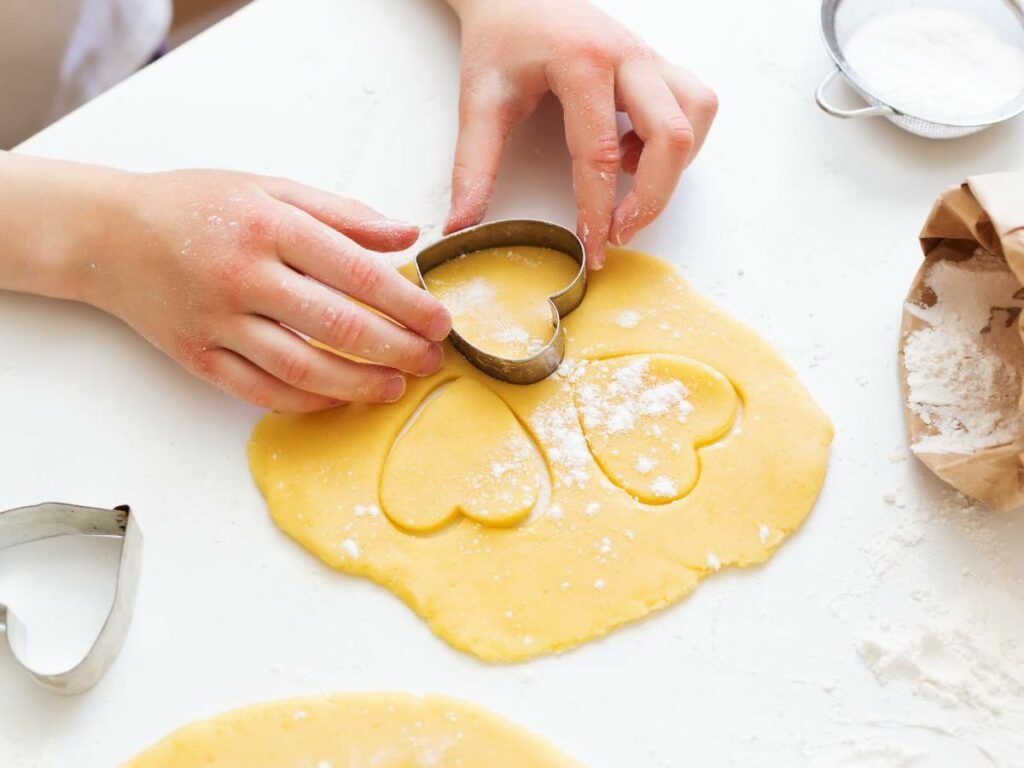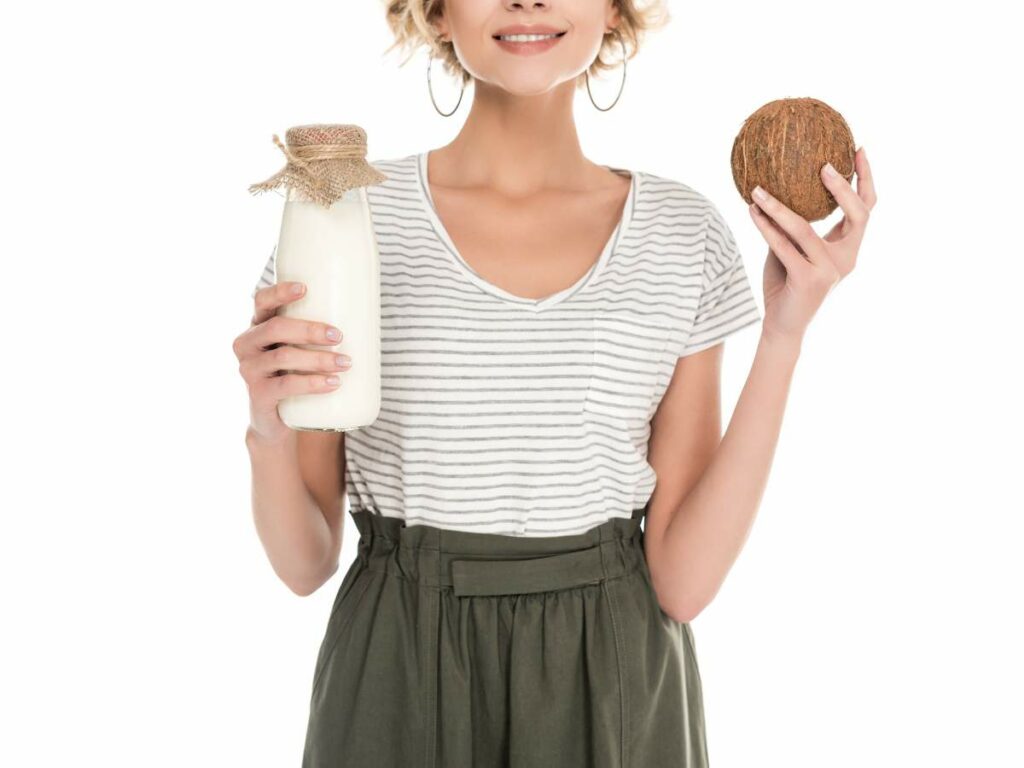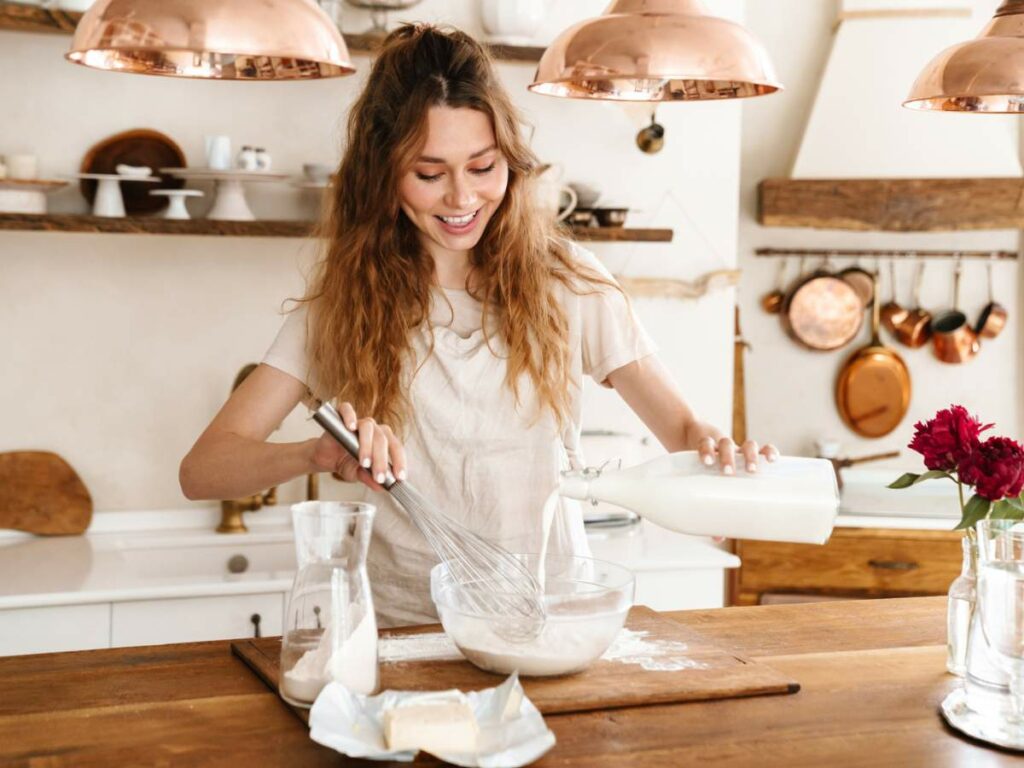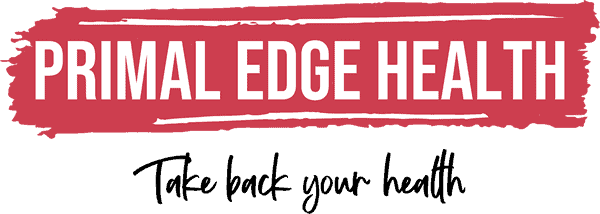Master the art of eliminating dairy from your favorite recipes with these dairy-free baking tips. When it comes to dairy-free swaps, you’ll need to know how to work them into your baked goods so that your treats come out perfect every time.

When you’re just starting out, making delicious treats at home might seem impossible without using dairy products. But in recent years, more people have started baking dairy-free because of the multiple benefits of a dairy-free diet, and there are more recipes and products available than ever before.
Now, with many new options, you can bake dairy-free easily using the proper techniques and alternative ingredients and substitutes. Don’t freak out if you have a huge sweet tooth and have to go dairy-free. Use these baking tips to create delicious desserts like flourless brownies, chocolate pumpkin bread, chocolate cake, and more.
Table of Contents (click to view)
Expert Tips on Dairy-Free Baking
Dairy-free baking seems daunting, especially if you’re used to baking with milk, butter, cream, and other common dairy ingredients. That’s why I’ve compiled some of the best tips I’ve learned over the years after trying dairy-free alternatives.
Below are six tried and tested dairy-free baking tips, ranging from using dairy alternatives and substitutes for enhancing flavor. Though it may seem overwhelming at first, once you get used to baking without dairy, it will become second nature, and you’ll reap the benefits of going dairy-free.
1. Research Suitable Dairy-Free Alternatives
Finding the correct dairy-free alternatives for dairy products is the most crucial step in successfully baking dairy-free. Every alternative has a unique flavor profile, so you must choose carefully. Here are a few dairy-free options you can consider to replace dairy products in your baked goods recipe:
- Milk replacements: Non-dairy milk is popular these days and easy to use. Some options are coconut milk, almond milk, hemp milk and oat milk. In most baking recipes, you can use these substitutes in the same quantity as regular milk.
The exception to this rule is coconut milk, which I use the most. Full-fat coconut milk from a can is ideal for thick, creamy recipes but cannot be subbed for regular milk.
- Butter replacements: You can use coconut oil to replace regular butter in a 1:1 ratio. Among other butter substitutes, nut butter can replace regular butter too.
2. Stick to Dairy-Free Baking Recipes at First
As a beginner, finding dairy replacements can add a lot of stress to the baking process. You can make mistakes and ruin perfect dishes if you don’t understand what substitute will work the best. Learn more about the best dairy-free swaps to make your transition easier.
Contrary to popular belief, there are tons of baking recipes that use no dairy products. I recommend sticking to such recipes when you start your dairy-free baking journey, like these dairy-free pumpkin muffins that take advantage of pumpkin’s natural creaminess.
That way, you don’t need to worry about making changes and messing up ingredient proportions or quantities. You will feel less pressured about finding the proper dairy replacements and be successful when you bake something new. Something like chocolate almond flour cookies is another classic dairy-free recipe, perfect for beginners to get started with.

3. Pay Attention to Labels for Hidden Dairy
Going dairy-free will be challenging, especially with dairy hidden in places and ingredients you won’t expect. Read labels for everything you purchase before you put it in the shopping cart or use it in your recipe.
A lot of sauces, most packaged food and baked goods contain dairy in the form of skim milk powder as a common ingredient. So, make sure that you double-check the ingredients before just grabbing them off the shelf.
“Because dairy is one of the big eight, it has to be listed on all labels, which makes it easier to identify than some other allergens. Dairy can hide in more names that sound nothing like dairy than you would expect, so this is critical when you read labels.”
— Michelle Price, Honest and Truly
4. Find Replacements That Add Moisture to Baked Goods
A primary role that most dairy products play in baking recipes is to add moisture to them. When you remove dairy, you must find ways to add moisture so your baked goods are fluffy. This is especially important if you bake gluten-free, too, as those flours absorb more liquid.
Natural sources like fruit purees are the best way to add moisture to baked goods. For example, you can add applesauce or mashed bananas for moisture and sweetness. Dairy-free yogurt works really well, too. These can also help improve the texture.
5. Enhance Flavor With Spices and Extracts
It might seem impossible to create a delicious dish without butter or milk. Generally, the trick is to use extracts or spices to compensate for the lack of flavoring because of dairy.
Cinnamon, nutmeg, vanilla extract and other spices and extracts are popular options in baked goods recipes. PIcking the right vanilla beans to use can also ramp up the flavor.
6. Coconut Milk for Richness
Full-fat coconut milk from the can is the key to creating ultra-rich desserts. Used properly, full-fat coconut milk can be a staple pantry ingredient to make your own dairy-free caramel sauce, dairy-free chocolate ganache and even chocolate fudge.
“Whenever I bake, I always swap in canned coconut milk to replace dairy milk and butter-flavored coconut oil if the recipe calls for butter. If cream is called for in a recipe, I use canned coconut cream. All are super convenient, don’t have an overwhelming coconut taste and work like a charm!”
—Gena, Ginger Casa
Why Should You Try Baking Dairy-Free?
Dairy-free baking often comes with a learning curve, but the benefits can outweigh the time it takes to master this. Let’s explore some specific advantages of dairy-free baking:
- People with lactose intolerance can enjoy baked goods without the discomfort that comes with eating dairy, such as nausea, belly cramps, and diarrhea. Plus, dairy-free baking gives a chance to recreate store-bought desserts that don’t come in dairy-free versions.
- Dairy-free baking offers tasty alternatives for vegans who can’t consume any animal products. This benefit also applies to anyone who just wants to lower their dairy consumption.
- You can swap regular chocolate with dairy-free alternatives and lower your histamine intake. Chocolate and other cocoa-based products can have higher levels of histamine, which is bad news for people with histamine intolerance.
- Some dairy-free alternatives are lower in calories and fat, which can be helpful if you’re trying to lose weight through calorie and fat reduction.
- Going dairy-free can also reduce your exposure to antibiotics and hormones, which are present in many conventional dairy products.
- A dairy-free diet can help reduce acne, wherein a substantial intake of dairy plays a role. If you have stubborn acne, try eliminating dairy from your diet and see what happens.
- Baking dairy-free can make you a better baker. At the end of the day, finding substitutions and alternatives for dairy can increase your skills as a baker (and cook, for that matter). Plus, you can increase your knowledge of food in general, especially if you have certain intolerances.

Dairy-Free Dessert Ideas
Baking without any dairy is not as hard as it seems. If you’re stuck on thinking about what to bake, get started with a pumpkin bread. Don’t think it’s only for fall, if you can make this anytime with canned pumpkin. This is a great example of how fruit or vegetable puree builds the texture without milk. Finish it off with a quick dairy-free keto icing.
FAQs About Dairy-Free Baking
Ingredients like milk and butter can be substituted with coconut milk, hemp milk or almond milk. As for butter, using coconut oil works for most baked goods.
Plant-based milk can be used as a milk replacement at a 1:1 ratio.
You can use various egg substitutes, such as mashed banana, applesauce, flaxseed meal, chia seeds, or commercial egg replacers. These alternatives work well in most baking recipes.
Enjoy Your Favorite Desserts Without the Dairy
Because dairy products play an enormous role in baking, it might sound impossible to bake without them. But that doesn’t mean you have to quit consuming baked goods altogether. Master some of the tips above to satisfy your sweet tooth and feel comfortable in your baking abilities.
Portions of this article originally appeared on Fit as a Mama Bear.


I love to bake but I just learned I may have a dairy intolerance. WAH! I’ll be doing an elimination experiment and at least I can try out some of my favorite baked goodies with these substitutes. Thanks for sharing your tips!
Happy baking, Nell. I hope you find lots of substitutes that works for you. Thank you for the warm feedback!